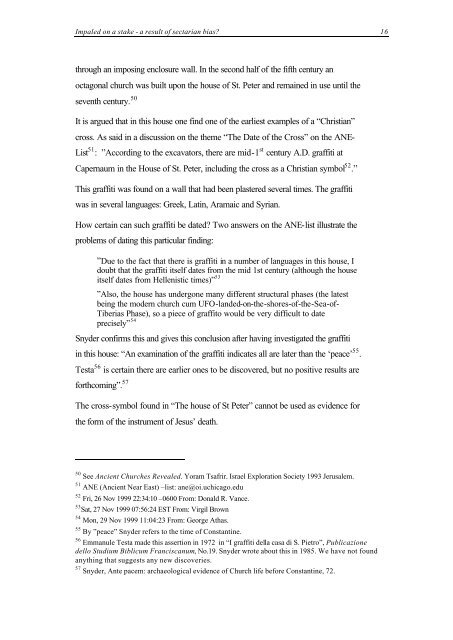Impaled on a stake — a result of sectarian bias?
Create successful ePaper yourself
Turn your PDF publications into a flip-book with our unique Google optimized e-Paper software.
<str<strong>on</strong>g>Impaled</str<strong>on</strong>g> <strong>on</strong> a <strong>stake</strong> - a <strong>result</strong> <strong>of</strong> <strong>sectarian</strong> <strong>bias</strong>? 16<br />
through an imposing enclosure wall. In the sec<strong>on</strong>d half <strong>of</strong> the fifth century an<br />
octag<strong>on</strong>al church was built up<strong>on</strong> the house <strong>of</strong> St. Peter and remained in use until the<br />
seventh century. 50<br />
It is argued that in this house <strong>on</strong>e find <strong>on</strong>e <strong>of</strong> the earliest examples <strong>of</strong> a “Christian”<br />
cross. As said in a discussi<strong>on</strong> <strong>on</strong> the theme “The Date <strong>of</strong> the Cross” <strong>on</strong> the ANE-<br />
List 51 : ”According to the excavators, there are mid-1 st century A.D. graffiti at<br />
Capernaum in the House <strong>of</strong> St. Peter, including the cross as a Christian symbol 52 .”<br />
This graffiti was found <strong>on</strong> a wall that had been plastered several times. The graffiti<br />
was in several languages: Greek, Latin, Aramaic and Syrian.<br />
How certain can such graffiti be dated? Two answers <strong>on</strong> the ANE-list illustrate the<br />
problems <strong>of</strong> dating this particular finding:<br />
”Due to the fact that there is graffiti in a number <strong>of</strong> languages in this house, I<br />
doubt that the graffiti itself dates from the mid 1st century (although the house<br />
itself dates from Hellenistic times)” 53<br />
”Also, the house has underg<strong>on</strong>e many different structural phases (the latest<br />
being the modern church cum UFO-landed-<strong>on</strong>-the-shores-<strong>of</strong>-the-Sea-<strong>of</strong>-<br />
Tiberias Phase), so a piece <strong>of</strong> graffito would be very difficult to date<br />
precisely” 54<br />
Snyder c<strong>on</strong>firms this and gives this c<strong>on</strong>clusi<strong>on</strong> after having investigated the graffiti<br />
in this house: “An examinati<strong>on</strong> <strong>of</strong> the graffiti indicates all are later than the ‘peace’ 55 .<br />
Testa 56 is certain there are earlier <strong>on</strong>es to be discovered, but no positive <strong>result</strong>s are<br />
forthcoming”. 57<br />
The cross-symbol found in “The house <strong>of</strong> St Peter” cannot be used as evidence for<br />
the form <strong>of</strong> the instrument <strong>of</strong> Jesus’ death.<br />
50 See Ancient Churches Revealed. Yoram Tsafrir. Israel Explorati<strong>on</strong> Society 1993 Jerusalem.<br />
51 ANE (Ancient Near East) –list: ane@oi.uchicago.edu<br />
52 Fri, 26 Nov 1999 22:34:10 –0600 From: D<strong>on</strong>ald R. Vance.<br />
53 Sat, 27 Nov 1999 07:56:24 EST From: Virgil Brown<br />
54 M<strong>on</strong>, 29 Nov 1999 11:04:23 From: George Athas.<br />
55 By ”peace” Snyder refers to the time <strong>of</strong> C<strong>on</strong>stantine.<br />
56 Emmanule Testa made this asserti<strong>on</strong> in 1972 in “I graffiti della casa di S. Pietro”, Publicazi<strong>on</strong>e<br />
dello Studium Biblicum Franciscanum, No.19. Snyder wrote about this in 1985. We have not found<br />
anything that suggests any new discoveries.<br />
57 Snyder, Ante pacem: archaeological evidence <strong>of</strong> Church life before C<strong>on</strong>stantine, 72.



